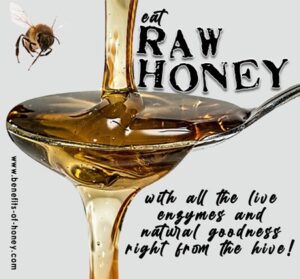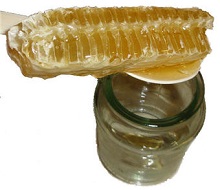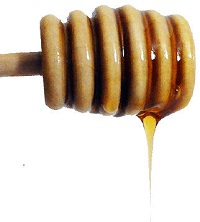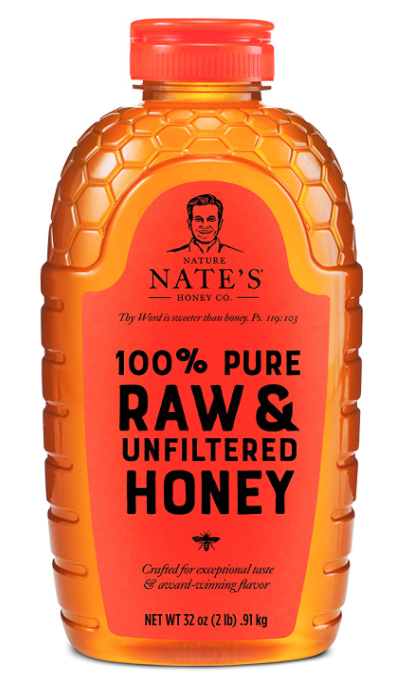raw honey
Best Raw Honey Buying Tips – 3 Things You Need to Know
What is raw honey? What is in raw honey? Why isn’t all honey raw?
It’s probably not too difficult to remember well what “raw” means when you associate it with uncooked vegetables and meat whereby any form of heating is avoided so as to ensure all the natural vitamins and living enzymes and other raw whole foods nutrients and health benefits are preserved.
1. What is Raw Honey Good for? Why is it Special?
Raw honey is the most original sweet liquid that honeybees produce from the concentrated nectar of flowers. Collected straight from the honey extractor; it is totally unheated, unpasteurized, unprocessed honey. Pure means not mixed or adulterated with any other substance or material. Hence pure honey does not have anything added to it.

An alkaline-forming food, raw honey honey contains ingredients similar to those found in fruits, which become alkaline in the digestive system. It doesn’t ferment in the stomach and it can be used to counteract acid indigestion. When mixed with ginger and lemon juices, it effectively relieves nausea and supplies energy. Raw foodists love raw honeycomb for its exceptional nutritional value and its amylase, an enzyme concentrated in flower pollen which helps predigest starchy foods like breads.
Other popular uses of raw honey include relieving seasonal allergies (using local raw honey), relieving cough, treating acne skin, and as a nutritious food during pregnancy, and an effective face mask ingredient.
2. Raw Honey vs Regular Honey – Most Supermarket Honey is Not Raw
A lot of honey found in the supermarket is not raw honey but “commercial” regular honey, some of which has been pasteurized (heated at 70 degrees Celsius or more, followed by rapid cooling) for easy filtering and bottling so that it looks cleaner and smoother, more appealing on the shelf, and easier to handle and package.
Pasteurization kills any yeast cell in the honey and prevents fermentation, which is a concern for storing honey with high moisture content over a long period especially in warm weather. While fermentation does not pose a health danger (mead is fermented honey), it does affect the taste of honey. Heating also slows down the speed of crystallization in liquid honey. On the downside, when honey is heated, its delicate aromas, yeast and enzymes which are responsible for activating vitamins and minerals in the body system are partially destroyed.

Among manufacturers there exists no uniform code of using the term “raw honey”. There are no strict legal requirements for claiming and labelling honey as “raw”. Nevertheless, suppliers who understand that honey that has undergone heat treatment would not be as nutritious and have the consumers’ health in mind would ensure their honey is only slightly warmed (not pasteurized), just enough to allow the honey to flow for bottling.
Thus, you may also find raw honey that are unprocessed but slightly warmed to retard granulation for a short period of time and allow light straining and packing into containers for sale. Using as little heat as possible is a sign of careful handling by honey suppliers.
 3. Raw Honey Granulates Over Time and is Not Crystal Clear
3. Raw Honey Granulates Over Time and is Not Crystal Clear
Usually raw unfiltered honey can only be purchased directly from the bee farm. Characterised by fine textured crystals, it looks cloudier and contains particles and flecks made of bee pollen, honeycomb bits, propolis, and even broken bee wing fragments. Raw unfiltered honey health benefits include high level of live enzymes, higher energy level, better digestion, and high antioxidant level.
Unpasteurized raw honey will usually granulate and crystallize to a thick consistency after a few months. It is usually preferred as a spread on bread and waffles, or dissolved in hot coffee or tea. However, as most consumers are naturally attracted to buying and eating crystal clear and clean honey, unfiltered honey which looks cloudy and unappealing, is not commercially available on most supermarket shelves.
Forms of Honey
Honey comes in different forms – raw honey with comb, raw honeycomb, liquid honey, and cream honey. Find out why each of the forms is preferred by different people for different reasons in: Forms of Honey
HONEY QUIZ
Discover how much you know about honey with this quick quiz. Your quiz results might well surprise you! All in: Do you really know me, honey?
Color and Flavor of Honey

Color is used in the honey industry as a convenient measure of honey flavour and aroma. Generally, lighter honeys have a milder flavor and darker honeys have a more robust flavor. The color and flavour of honey is largely determined by the floral source of the nectar. However, exposure to heat and storage time may affect honey’s quality and color. Normally, the darkening of honey occurs more rapidly when honey is stored at high temperatures. Also, honey appears lighter in color after it has granulated, which is why most creamed honeys are opaque and light in color.
Other Related Articles
1) Is it safe to eat raw honey? Can be be safely consumed during pregnancy? It is safe for adults to eat honey. More in Warning on Honey and Infant, Can be be safely consumed during pregnancy? 5 Benefits of Eating Honey During Pregnancy, and Honey Allergy (Cause and Concern).
2) Get these terms and concepts straight – pure honey, creamed honey versus clear liquid honey, crystallisation of honey, honeycomb, monofloral varietals, darkening of honey, viscous versus runny honey, honey storage, and more in: Frequently Asked Information About Honey.
3) How is organic honey differentiated from regular honey? More in: What Makes Organic Honey Different?
4) With so many terms such as raw, pure, organic, etc, buying honey can be tricky. My take on Which Honey to Buy?
5) How much do you trust the labels on the honey jars?: More in: Eating Real Honey?
6) Want an effective home remedy for acne? Find out more about raw honey benefits for skin in: 7 Best Honey And Tea Tree Oil Face Masks For Acne Skin
7) Read about my online find – raw honey (unfiltered): Really Raw Honey!
8) Does wild honey really taste sour? And does it produce a clear solution when mixed with water? Wild Honey Questions. Need Your Help!
9) Honey claims and labels can be confusing. Get tips that would lend you some clues about honey labeling: Natural Honey, Pure Honey, Raw Honey ~ Making Sense of Honey Labels.
10) Learn about issues related to honey crystallization, pasteurization, and get the best tips for handling and storing honey: Honey Storage Tips.
11) Is honey powder another form of honey? Is it really made of 100% honey?: What in the World is Honey Powder?.
12) Where can I find raw honey and raw honeycomb near me? If you are located in Singapore, check out: Bee Healthy. Otherwise, you could consider Amazon which offers countless choices of raw honey for sale at great prices and international shipping.
